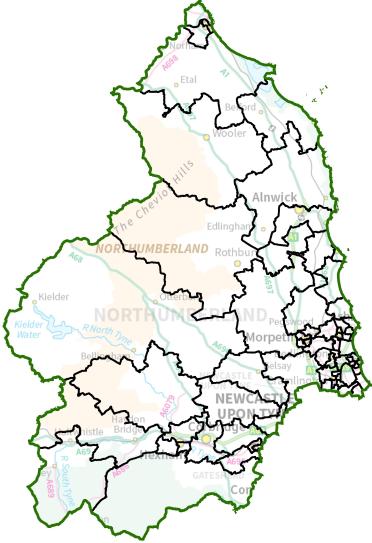Have your say on a new political map for Northumberland County Council

New boundaries are being proposed for council divisions in Northumberland County Council.
The Local Government Boundary Commission wants to hear what residents and local organisations think about the proposals. A 10-week consultation on the proposals will run until 10 July 2023.
Proposed divisions for Northumberland
Click map for high resolution version
Credit: contains Ordnance Survey data (c) Crown copyright and database rights 2023
The Commission is the independent body that draws these boundaries. It is reviewing Northumberland to make sure councillors will represent about the same number of electors, and that division arrangements will help the council work effectively.
The Commission has published proposals for changes to Northumberland. It is proposing that there should be 67 single-councillor divisions and one two-councillor division. Northumberland should have 68 divisions, two more than there are now. Most divisions will change, thirteen will stay the same.
Proposed changes include:
- An increase to the council size for Northumberland from 67 councillors to 69 councillors in these draft recommendations. This will allow a division pattern that reflects both the urban and rural parts of the county.
- Retaining one two-councillor division in Northumberland based on the evidence received during consultation on division patterns. That division is Alnwick.
- Changes to divisions across the rest of the county with substantial changes in the Ashington, Blyth, Cramlington, Hexham, Morpeth and Seaton Valley areas.
- The amendment of the divisions of Bellingham and Rothbury to provide for electoral equality in those divisions.
Launching the consultation Professor Colin Mellors, Chair of the Commission, said:
“We want people in Northumberland to help us.
We have drawn up proposals for new electoral divisions in Northumberland. We want to make sure these new electoral arrangements reflect communities. We also want them to be easy to understand and convenient for local people.
Residents and local organisations can help us do that. We would like them to let us know whether they agree with our proposals before we take final decisions.
It’s easy to get involved. Go to our website. Or you can e-mail or write to us.
Just tell us what you think and give us some details why you think that. It’s really simple, so do get involved.”
The Commission has a dedicated section on its website where people can see the detail of the proposals and comment on the names of electoral divisions and their boundaries. www.lgbce.org.uk/all-reviews/northumberland
People can also give their views by e-mail at reviews@lgbce.org.uk, and by post:
Review Officer (Northumberland)
LGBCE
PO Box 133
Blyth
NE24 9FE
Ends/
Notes to editors:
This consultation relates to arrangements for local government elections. It is separate from the review of parliamentary constituencies that is currently taking place.
For further information contact the Commission’s press office on 0330 500 1525 / 1250 or email press@lgbce.org.uk
An interactive map is available at www.lgbce.org.uk/all-reviews/northumberland.
The Local Government Boundary Commission for England is an independent body accountable to Parliament. It recommends fair electoral and boundary arrangements for local authorities in England. In doing so, it aims to:
- Make sure that, within an authority, each councillor represents a similar number of electors
- Create boundaries that are appropriate, and reflect community ties and identities
- Deliver reviews informed by local needs, views and circumstances
- Reflect the request for single-member divisions

